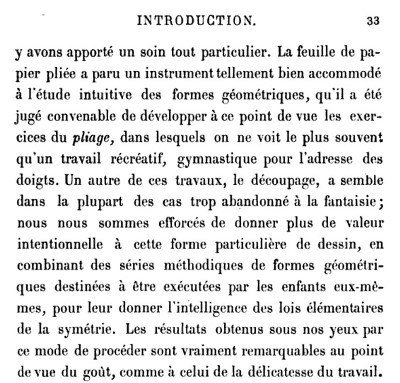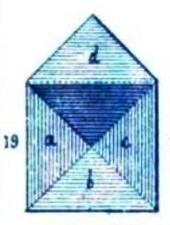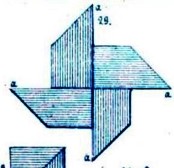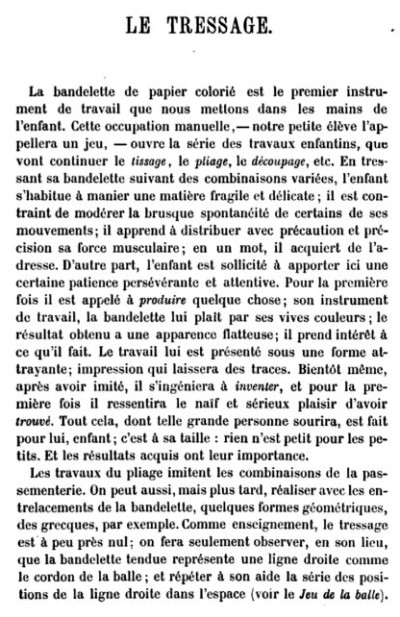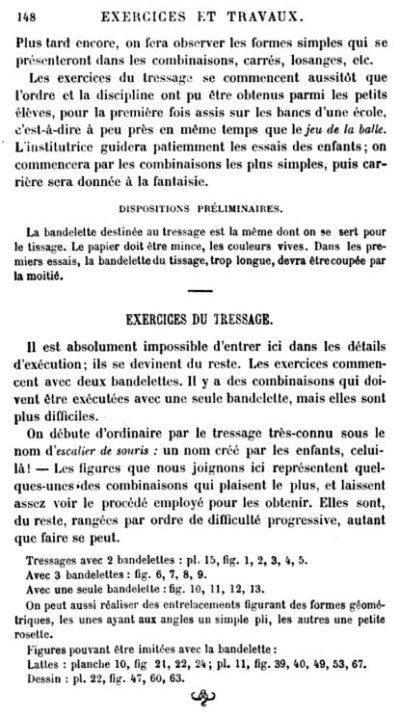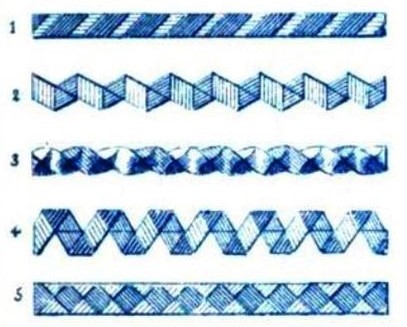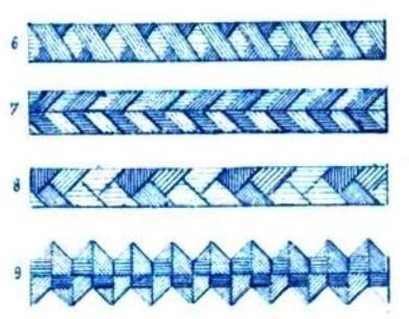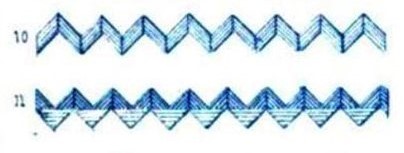| The Public Paperfolding History Project
Last updated 20/8/2025 x |
|||||||
| Exercices et Travaux pour les Enfants by Fanny and Charles Delon, 1873 | |||||||
| 'Exercices
et Travaux pour les Enfants Selon la Méthode et les
Procédés de Pestalozzi et de Froebel' by Fanny and
Charles Delon was published by Librairie Hachette in
Paris in 1873. It contains chapters on Le Tressage
(Braiding), Le Pliage (Simple Folds of Life, Folds of
Life (list only), Forms of Beauty) and Le Decoupage
(Ausschneiden und Aufkleben). A full copy of the work can be accessed online here. **********
********** The Introduction says, inter alia ...
**********
********** Analysis Le Pliage This part of the work first gives some limited information about Folds of Life (les objets usuels) and then presents a series of exercises designed to teach basic geometric principles through the use of paperfolding. Some of these exercises explain how to create Folds of Beauty from the Double Blintz Basic Form, the Windmill Base and the Windmill itself (although there is no reference to Folds of Beauty as a class of designs). Other exercises treat simple geometric shapes as Simple Froms of Life. ********** Des Objets Usuels - Folds of Life There are no illustrations or descriptions of these Folds of Life, and the designs do not seem to be listed in any kind of developmental order.. Identification of many of the designs is problematical.
The most likely identifications are: 1. La saliere - probably The Saltcellar 2. La mitre persane (the Persian mitre) - possibly The Mitre. 3. Le pantalon d'enfant (children's pants). This title is reminiscent of 'La veste du mineur' in 'Manuel Pratique de Jardins d'Enfants de Freidrich Froebel' by J-F Jacobs, published in Brussells and Paris in 1859 which seems to refer to the Jacket. This may also be the design intended here. 4. Le coq - probably The Cocotte / Pajarita 5. La double pirogue (the double canoe) - probably The Double Boat 6. La barque a voiles (the boat with sails). This title is reminiscent of the title 'La gondole à voiles' used as name for the Chinese Junk in 'Manuel Pratique de Jardins d'Enfants de Freidrich Froebel' by J-F Jacobs, published in Brussells and Paris in 1859. 7. La boite a double couvercle (the box with two lids) - probably The Junk Box 8. Le cadre (the frame) - probably The Picture Frame 9. Le berceau (the cradle) - probably The Boat with Sail. 10. La chemisette (the shirt) - probably The Collar. 11. La table - probably The Table 12. La portefeuille (the wallet) - unidentifiable. 13. La gondole (the gondola) - possibly The Gondola 14. Le petit soufflet (the little bellows) - probably The Bellows 15. La lettre a deux cachets (the letter with two stamps) - unidentifiable. 16. La casquette a visiere (the cap with visor) - unidentifiable. 17. Le porte-monnaie (the wallet) - possibly The Portfolio 18. Le papillon (the butterfly) - unidentifiable. 19. La boite close (the closed box) - unidentifiable 20. L'etoile a quatre rayons (the star with four rays) - unidentifiable. 21. La chaise (the chair) - possibly The Chair 22. La serviette dans son rouleau (the serviette in its roll) - unidentifiable. ********** Geometric Forms - Simple Folds of Life In the course of the first few exercises the simple geometric folds shown below are said to represent: Picture 15. Les feuillet d'un livre - The leaves of a book Picture 16. Un mouchoir plie - A handkerchief folded in two by the corners Picture 17. Un fichu - A handkerchief folded in four by the corners
*********** Similarly, picture 18 is said to represent 'La forme du pignon d'une maison' (The shape of a gable of a house)
********** And picture 19 'Une enveloppe ouverte' (An open envelope).
The text says that folding in the fourth corner produces the lettre close (closed letter) ********** In the Troisieme Exercise of the Premiere Serie the blintzed square is turned over and blintzed again, to create the Double Blintz Basic Form, and in the process the same Simple Folds of Life are discovered again, but called the small gable, the small letter, the small envelope.
********** Folds of Beauty In the Quatrieme Exercise of the Premiere Serie, the Double Blintz Basic Form is used as the basis of Folds of Beauty, although this term is not used.
********** In the Cinquieme Exercise of the Premiere Serie the other side of the Double Blintz Basic Form is used to create other Forms of Beauty.
********** The Sixieme Exercise of the Premiere Serie suggests turning the points of the design shown in picture 24 inwards to create a frame and combining the desogns shown in pictures 24 and 25 to create a new design with 'binary symmetry'. These designs are not illustrated. ********** The Septieme Exercise of the Premiere Serie explains how to turn the Double Blintz Basic Form into The Windmill Base and how to develop it to create designs that resemble pictures 21 and 24.
********** The folding instructions in the Premiere, Deuxieme, Troisieme and Quatrieme Exercises of the Deuxieme Serie explain various ways of developing the Windmill Base into further Folds of Beauty, not all of which are easy to follow. Three of these, which I call The Diagonal Cross, Four Kites, and Four Pointsare illustrated:
********** The Premiere Exercise of the Troisieme Serie suggests that 'mixed forms' can be created by combining elements from the various Windmill Base designs..
********** The folding instructions of the Deuxieme Exercise of the Troisieme Serie explain how to make the 'moulinet a ailettes' ie The Windmill.
********** The Troisieme Exercise of the Troisieme Serie describes how to make Folds of Life from the Windmill Base.
********** Note that pictures 34 to 36 of Plate 15 do not appear to be referred to in the text. ********** Le Tressage This chapter deals with the folding and braiding of paper strips. Inter alia the author says 'The strip of coloured paper is the first work instrument we place in the child's hands' ... 'at about the same time as the ball game' but observes that 'For teaching braiding is almost useless.' Braids made from two strips are the easiest, then thise made from three and finally from one.
********** Braids made from Two Strips
********** One of these is d'escalier du souris' (The Mouse Stairs) ie The Witch's Ladder
********** Braids made with Three Strips
********** Braids made from a Single Strip
********** La Decoupage - Ausschneiden und Aufkleben
********** |
|||||||


